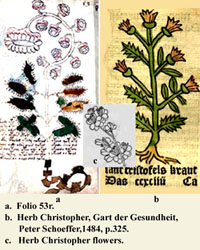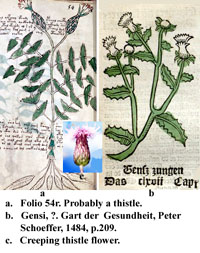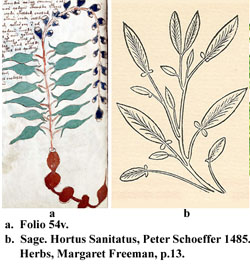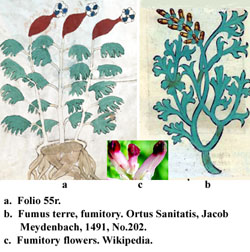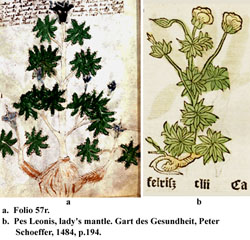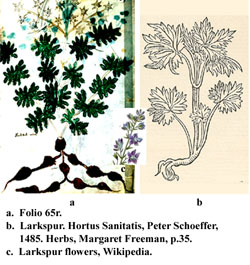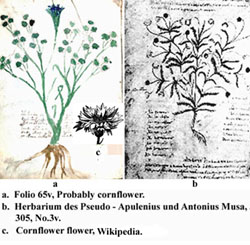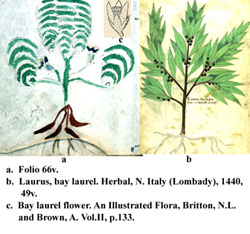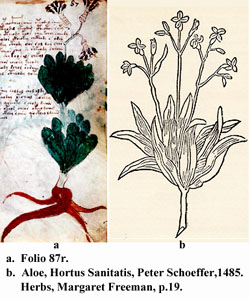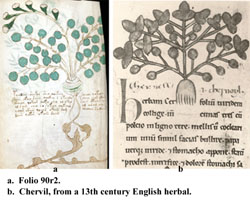The Voynich Botanical Plants
Folio 53r. Herb Christopher (Actaea spicata). This plant is also known as baneberry. It is a member of the ranunculaceae family and its black berries are extremely poisonous. These berries when mixed with alum yield a black dye. (B)
Folio 54r. Creeping thistle (Circium arvense). This plant is also known as the cursed thistle as it readily spreads underground from its rhizomes and is considered a noxious weed. The roots are edible but produce flatulence in some people and the leaves are too prickly to eat. (1) (B)
Folio 54v. Sage (Salvia officinalis). Sage was an important ingredient in Medieval cooking. Bancker’s Herbal notes that sage “soothest the nerves, quietest the shaking of the palsy, improved digestion. It is good for the venom or poison. Seethe sage in wine or ale and use to drink in three days and thou shall be made good, by the grace of God. Also if a man has an itching, wash the itching well with the juice of this herb and it shall slay the itching soon.” (2) (B)
Folio 55r. Fumitory (Fumaria officinalis). Early herbalists considered that fumitory was good for the eyes. It was used externally in an antiseptic and anti-inflammitory lotion for acne and exema, and also to fade freckles. Modern herbalists use it to treat skin diseases, conjunctivitis and also to cleanse the kidneys. Fumitory is poisonous and should be used with extreme care. (1) (B)
Folio 57r. Lady’s Mantle (Alchemilla vulgaris). In the Middle Ages this plant was associated with the Virgin Mary; the scalloped leaves resembling the edge of her mantle. Nicholas Culpeper claimed that lady’s mantle is “very proper for inflamed wounds and to stay bleeding, vomiting, fluxes of all sorts, bruises by falls and ruptures. … Drink a decoction thereof and wash the wound therewith. It drieth up all humidity of the sores and abateth all inflammations thereof.” (4) (B)
Folio 65r. Larkspur / Delphinium. The main use for this herb in the Middle Ages was to rid the head of lice. Crescentius says, “The seed made into powder and mixed with vinegar is a good salve for lice and scabs. That is why it is called lousewort. … Also the powder taken in honey kills worms.” (2) (B)
Folio 65v. Cornflower (Centaurea cyanus). The pigment extracted from the flowers is mixed with alum-water to create an ink. Culpepper, considered that the seeds or leaves taken in wine would ward off the plague and all infectious diseases. Cornflowers are often used to flavor some blends of tea, like Lady Grey. (1) (B)
Folio 66v. Bay laurel (Laurus nobilis). Bancker’s Herbal states that bay is “good to purge a man of phlegm and the choler. It is good for a man that may not hear, for if the juice thereof be put in his ears … it will heal it.” The Grete Herball adds that “for colic a bath made of bay leaves is good. Also against the evil color of the face … and also the manner of red things that come in young peoples faces … take new bay berries and put out the hulks and make fine powder put it in honey and anoint or bathe the face.” (2) (B)
Folio 87r. Aloe (Aloe vera). Dioscorides mentions the bitter taste of aloes. He describes the value of aloe juice, from the “conglutinating of wounds and loosening of the belly to procuring of sleep and preventing the hair falling off.” The Grete Herball adds that this herb is “good for worms in the belly and ears and for ill color caused of the coldness of the stomach” (2) (B)
Folio 90r2. Chervil (Arthriscus cerefolium). The plant we know today as chervil looks nothing like these two illustrations. (B)
